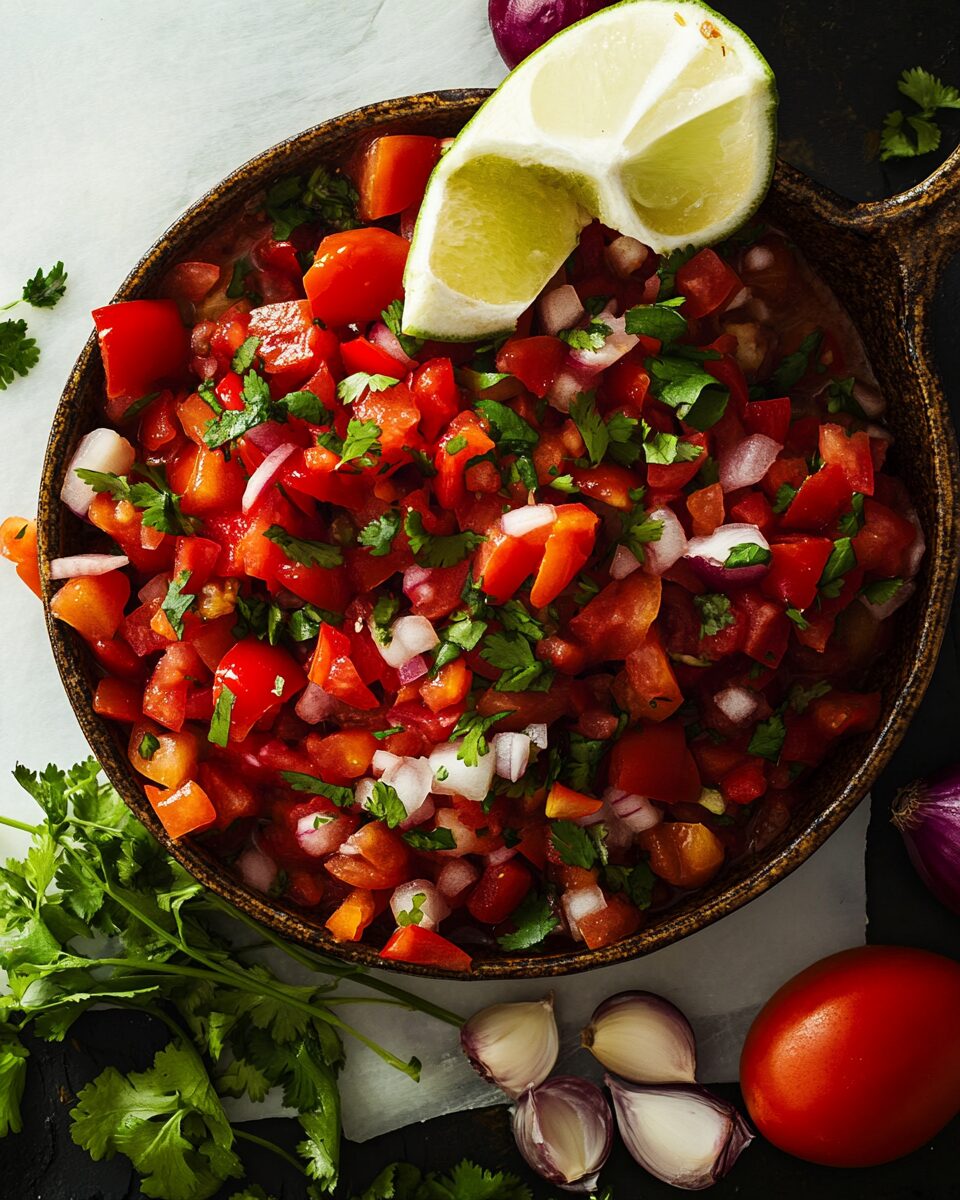This classic Mexican Pico de Gallo is the epitome of fresh and simple. Made with ripe tomatoes, minced serrano chiles, chopped onion, and fresh cilantro, this chunky salsa is brightened up with freshly squeezed lime juice. It’s a must-have for summer cookouts, taco nights, or as a refreshing dip.
Whether you’re serving it alongside chips, spooning it over grilled chicken, or using it to bring life to your breakfast eggs, Pico de Gallo brings unbeatable zest to your plate. With only a handful of wholesome ingredients and minimal prep, this versatile condiment is proof that sometimes, the best dishes are also the simplest.
Full Recipe:
1 1/2 pounds yellow or red tomatoes, seeded and chopped
1 small onion, chopped
1/2 cup chopped fresh cilantro leaves
3 tablespoons fresh lime juice
2 serrano chiles, seeded and minced
Pinch kosher salt and fresh ground black pepper
Directions:
Add all the ingredients to a medium-sized mixing bowl.
Gently toss to combine, ensuring the lime juice and seasonings are evenly distributed.
Cover and refrigerate for at least 30 minutes to allow the flavors to meld.
Serve chilled as a dip with tortilla chips or as a topping for tacos, grilled meats, or seafood.
Prep Time: 10 minutes | Cooking Time: 0 minutes | Total Time: 40 minutes (includes chilling)
Kcal: ~25 kcal per 1/4 cup | Servings: 3 cups
What is Pico de Gallo?
Pico de Gallo, often referred to as “salsa fresca” or “salsa cruda,” is a traditional Mexican condiment that showcases the vibrant flavors of fresh produce. Unlike many cooked salsas, this dish is raw, keeping its ingredients crisp, colorful, and full of bright flavor. At its core, Pico de Gallo is a chopped mixture of tomatoes, onions, chilies, cilantro, lime juice, and salt. It is a simple recipe, but its taste and versatility are anything but basic.
The name “Pico de Gallo” literally translates to “rooster’s beak” in Spanish. While there are several theories about this unique name, one of the most popular beliefs is that it was traditionally eaten by pinching it between the thumb and forefinger—much like a bird’s beak. Another theory suggests the ingredients resemble bird feed. No matter the origin of the name, Pico de Gallo has transcended borders and is now enjoyed worldwide in a variety of culinary applications.
Cultural Significance and Origin
Pico de Gallo is deeply rooted in Mexican culinary tradition. It’s not just a condiment; it’s a cultural staple that reflects the country’s love for fresh, bold flavors. Its simplicity makes it a regular feature in both street food and home-cooked meals. You’ll find it served alongside tacos, grilled meats, or simply as a dip for tortilla chips.
In Mexico, this mixture is also known as “salsa mexicana” or “salsa bandera,” which means “flag sauce.” The colors of the ingredients—red (tomato), white (onion), and green (cilantro and chile)—mimic the Mexican flag, making it a symbol of national pride as well as a flavorful addition to meals.
Though every region in Mexico has its own variation of the dish, the base concept remains the same. Some versions may include cucumber, radish, mango, or even watermelon, but the classic tomato-based version remains the most widely known and loved.
The Freshness Factor
What sets Pico de Gallo apart from other salsas is its freshness. There’s no cooking involved, and the ingredients are used in their raw, most vibrant form. This not only preserves the flavor of each component but also retains their nutritional value. The tomatoes provide juiciness and umami, the onions offer a sharp bite, cilantro adds a citrusy herbaceousness, lime juice brings acidity and brightness, and the chiles introduce just the right amount of heat.
Choosing the right produce is essential. Ripe, in-season tomatoes will make a huge difference in taste. Similarly, the quality of your lime juice and the freshness of your herbs can elevate a simple Pico de Gallo from good to unforgettable.
Why This Recipe Works
Marcela Valladolid’s version of Pico de Gallo, as featured on Food Network, is a balanced, traditional take on this Mexican staple. What makes this recipe stand out is its perfect ratio of acidity, heat, and freshness. Using serrano chiles instead of jalapeños adds an authentic heat that’s slightly bolder but still manageable. Serranos are traditional in many Mexican homes and provide a distinct flavor profile.
Another detail that elevates this version is its resting time. Allowing the mixture to chill and marinate for at least 30 minutes before serving lets the flavors meld beautifully. The lime juice softens the onions and tomatoes, and the overall mixture becomes more cohesive and flavorful.
Versatility of Pico de Gallo
One of the greatest attributes of Pico de Gallo is its versatility. It can be used in a variety of ways:
As a dip – Serve it with tortilla chips for a quick and healthy appetizer.
On tacos – It’s the ideal topping for tacos of all types, from grilled chicken to carnitas.
With eggs – Spoon it over scrambled eggs or in a breakfast burrito for a morning kick.
In salads – Mix it with avocado or black beans for a quick and nutritious salad.
As a side – It pairs wonderfully with grilled fish, steak, or chicken, acting as a fresh and zesty relish.
You can even incorporate it into fusion dishes. Try it on burgers, hot dogs, or even baked potatoes for a fresh twist. The flavors of Pico de Gallo complement many cuisines and dishes beyond traditional Mexican fare.
Health Benefits
Not only is Pico de Gallo delicious, but it’s also incredibly healthy. It’s low in calories, fat-free, and packed with nutrients:
Tomatoes are rich in antioxidants, particularly lycopene, which is known for its heart health benefits.
Onions and chiles both have anti-inflammatory properties and contribute essential vitamins.
Cilantro is known for aiding digestion and detoxification.
Lime juice provides a good dose of Vitamin C, helping to support your immune system.
This makes Pico de Gallo a great addition to most diets, including vegan, gluten-free, keto, and low-sodium regimens.
Common Variations and Add-Ins
While the classic recipe is a favorite for a reason, it also serves as a blank canvas for customization. Here are a few creative variations you can try:
Avocado Pico de Gallo – Add diced avocado for creaminess and extra fiber.
Mango Pico de Gallo – Sweet mango chunks contrast beautifully with the savory base.
Corn Pico de Gallo – Add grilled or canned corn for a touch of sweetness and texture.
Watermelon Pico de Gallo – A perfect summer twist that’s refreshing and hydrating.
Radish or Cucumber Pico – Adds crunch and peppery or cool undertones.
These versions not only diversify your offerings but also cater to seasonal produce availability and personal taste preferences.
Tips for the Perfect Pico de Gallo
Use ripe, firm tomatoes: They should be juicy but not too watery. Roma or plum tomatoes are a great choice.
Remove seeds for a less watery salsa: Especially if serving with chips, as too much liquid can make them soggy.
Chop ingredients evenly: Uniform cuts make the salsa visually appealing and provide consistent flavor in every bite.
Season last: Add salt and pepper after mixing and tasting to avoid over-seasoning.
Let it rest: Don’t skip the chilling time—it’s essential for marrying the flavors.
Pico de Gallo vs. Salsa
Many people use the terms interchangeably, but there is a distinct difference between Pico de Gallo and other salsas. Most salsas are cooked or blended, making them smoother and more sauce-like in texture. Pico de Gallo, on the other hand, is always chopped and never cooked, giving it a chunkier, fresher bite.
While salsas are great for smothering enchiladas or spooning over grilled meats, Pico de Gallo offers a textural element that can’t be beat when you want crunch, freshness, and bite in a single spoonful.
How to Store and Make Ahead
Pico de Gallo can be made ahead of time—up to 4 hours in advance is ideal. This allows the flavors to develop without the tomatoes becoming too soggy. Store it in an airtight container in the refrigerator, and always give it a quick stir before serving.
If you have leftovers, they’ll last about 2 days in the fridge, though the texture might soften a bit. You can refresh it with a quick squeeze of lime juice and a sprinkle of salt.
Conclusion
Pico de Gallo is a shining example of how simple ingredients can come together to create something spectacular. It’s fresh, vibrant, healthy, and endlessly versatile. Whether you’re hosting a summer BBQ, meal-prepping for the week, or just craving something light and flavorful, this salsa is a go-to.
Marcela Valladolid’s version of this classic dish respects its roots while offering a balanced and approachable recipe anyone can make. From its cultural significance to its bright flavors and health benefits, Pico de Gallo deserves a place in every kitchen—and on every table.
So next time you’re chopping tomatoes, don’t just make a salad. Make Pico de Gallo, and bring a taste of Mexico to your meal.






